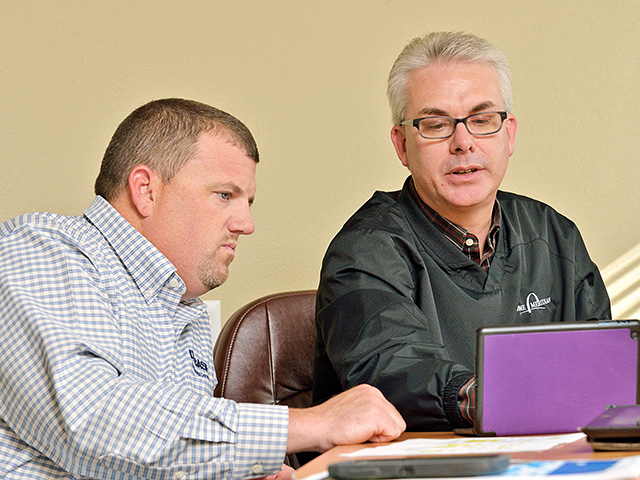This yearlong endeavor looks at how four farmers are evaluating technology and agronomic information that can boost the productivity of their operations.

The 2015 growing season has been a good teacher, and Steve Cubbage has been an attentive student.
"There’s been plenty to learn this year. Now, the challenge is to take that information and plug it in for next year’s crop," the Nevada, Mo., farmer says.
And at the top of his list is nitrogen.
"The whole protocol of putting all of your nitrogen down in late fall or even early spring is out the window," Cubbage explains.
This year, wet spring conditions prompted BASF Innovation Specialist Kaleb Hellwig to sample soil in–season to get a better handle on available nitrogen.
"We would have underestimated the sidedress N we needed," Cubbage says. "Based on Kaleb’s testing, we applied 10 to 20 pounds per acre more than we would have, and it looks like it paid off."
Cubbage also used strip tests to evaluate nitrogen inhibitor products, as well as side–dress N rates. "I think the inhibitors helped but we’ll have to look at the numbers after harvest," he notes.
The 2015 growing season convinced Cubbage to drop wheat from his cropping plans. Explaining, "The numbers just aren’t there right now," he reports problems with vomitoxin have also left him with wheat he cannot sell.
"We’re creating a silver lining from a bad situation," Cubbage explains. "Our goal is to get a cover crop on every acre, and we’re going to utilize that unsellable wheat as a cover crop to retain some value."
Dropping wheat will also provide an opportunity to repair terraces and waterways and accomplish other conservation tasks.
Wet weather delivered another lemonade–out–of–lemons opportunity. About 500 acres of intended double–crop soybean fields stayed too wet, too long. Those prevented planting acres were fallow until worked in August by a vertical tillage tool with an attached seeder delivering tillage radish seed.
"We normally aren’t able to get a cover crop in that early, and we got a great stand," Cubbage says. "We expect excellent tap root growth before it freezes, and that’s going to help break up compaction and facilitate nutrient movement in the soil."
The growing season also reinforced his belief in planting corn early.
"It’s difficult, but there’s a reason to push the limit on corn planting dates," says Cubbage. "Early–planted corn is, by far, our best. This year, a two– to three–week delay in planting probably cost us 30 to 40 bushels per acre. Next year I won’t hesitate to go the third week of March if the soil temperature is near 50º."
Although the verdict is still out, this year also piqued his interest in non–GMO corn.
"It looks good—I’d say it’s on a par with our better corn, and if that holds, it will be more profitable," he observes. The 2015 learning–and–growing process moved Cubbage Farms further down the road to a new herbicide strategy.
"Roundup is quickly becoming a secondary product," Cubbage explains. "Pre–emergence herbicides are back, and residual action is essential. We’re relying heavily on Kaleb Hellwig [BASF Innovation Specialist] to help us transition to a more effective chemical strategy."
For Cubbage and many other soybean growers, resistant waterhemp has become enemy number one, and that calls for deliberate action.
"The best approach for waterhemp is preventing it from coming up," Hellwig says. "No matter what system you’re using, it needs to be supported by layered residual herbicide applications."
Hellwig calls waterhemp "relentless," noting it can germinate from April through August in western Missouri. So regardless of the herbicide program used, it’s going to need some help.
Ideally, Hellwig suggests farmers make an herbicide application two weeks ahead of planting. Verdict and Zidua are among his top choices at that time. He recommends following up with a postemergence treatment of Roundup along with an herbicide such as Outlook.
"We expect four to five weeks of residual action on waterhemp, so our goal is to get the second layer on just as the first product is running out," Hellwig explains. "Generally, if we can keep the beans clean the eight to nine weeks the soybeans are canopied—they’re off and running."
He emphasizes that while most growers fight waterhemp, they likely have other unique weed challenges. "You can’t exclusively focus on waterhemp. Some products that are good for that weed aren’t particularly strong on others," Hellwig says. "You have to design a combination that fits your situation."
On the technology side, Cubbage is excited about the farm’s developing use of drone–generated, actionable aerial data.
"We’re still learning, but we’ve taken a big step forward using DroneDeploy," he says. "With their software, we download an app to an iPad and program a drone to fly a set pattern. We get a geo–referenced image in about 30 minutes.
"It’s more than just pretty pictures. It’s an accurate image of a given area that we can utilize for in–season assessments. We can spot shattercane early, ID pivot nozzles that need attention, locate compacted areas, make sure planter clutches are working correctly—things that you can still do something about or conditions you can address next season."
In the long run, Cubbage concludes, learning is the most important commodity a farmer can harvest.